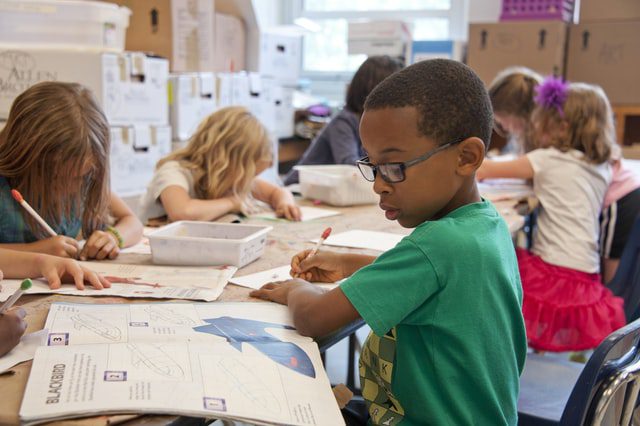
Gender Diversity Activities and Gender Inclusion in Schools
We have previously touched on how teachers can help transgender students at school. This article will be more expansive and will include school climate and gender inclusion at a universal level within a school. This will include information down to the gender identity policy development level.
If we are to foster safe and supportive environments for all children from minority groups (not just groups related to gender), regardless of the type of group, it will have to start at school level, even before elementary school. All staff members will have to actively model the ideals of acceptance, normalization, respect, and inclusion. There are too many students who are regularly being physically harassed at school just for belonging to a specific group.
A good place for schools to start is by providing definitions of things like gender identity, gender inclusion, sexual orientation, etc. Have official policies regarding things like bathroom and locker room use that parents can access before they enroll their children in the school.
A valuable policy to have at this level is to have resources to which families can be referred should a child present as transgender or otherwise struggle with their gender identities. Especially for when parents are unsure how to handle the situation and uncertain of what would be best for their children.
If schools are unsure how to get this climate change started, there are institutions that provide guidance and training to schools and staff. Gender expression is also a good foundation through which to teach children about their personal biases, how to be aware of them, and how to manage them so that they do not turn into acts of discrimination.
This platform can also be used to address problematic media images related to gender norms that might be making cisgender students uncomfortable as well. It is no secret that transgender people are not the only group of people who struggle with extreme examples of gender norms.

Key Role Players in Changing School Climate
School Leaders
Any changes that need to be made to the school must be modeled by the school leaders. They set the tone and expectations of how the rest of the faculty is expected to behave. If policies regarding language use, equality, and overall gender inclusion are released, the school leader should already be following them, and implementation should be based on what is modeled by the school leaders.
Also, consider what your hiring and employment policies say on gender. Do you have gender-specific and gender-inclusive policies? If not, how are you going to go about addressing that?
School leaders should fully understand gender diversity and how the well-being of transgender children and transgender youth can be protected. They should ideally have a close relationship with entities like the National Center for Transgender Equality and the Human Rights Campaign, and they should thus have a clear understanding of practices and norms related to supporting transgender youth and also LGBT+ youth that are enrolled in their schools.
School Administrators
The administration department is usually the middle man between the public and the school. If the school aims to be inclusive and wants to implement policies and behaviors supporting trans rights, then the administrators will be key role players in interactions with the public.
Therefore they will also model good behaviors that are expected and normalized among teachers and students at a broader level. There should also be policies in place for how administrators should respond to negative remarks and bias from parents.
Teachers
Teachers are the main driving force behind implementation of policies and behaviors among the student body. It will make no difference if policy prohibits discrimination, but teachers do not enforce these policies. The teachers in a school are the direct link between the rest of school staff and the student population. Therefore, what school leaders model to staff, teachers model to students.
The teacher will also be the one tasked to teach students the curriculum. Teachers will check that students are understanding gender identities and accepting gender diverse youth around them and their place within the spectrum. If students are struggling with this, the teacher needs to be equipped with resources to help students overcome these struggles.
Teachers will also be the ones implementing gender-diverse activities into the classroom and making sure that gendered language and activities are avoided. They will also make sure that any transgender and gender nonconforming students are comfortable to express their gender identity in the classroom. Gender diversity should be a safe topic to discuss in gender-inclusive schools.
Teachers are responsible for designing classroom materials and ensuring that these materials are appropriate for the age group of their students. An elementary school teacher is the one who lays the foundation that a high school teacher will build on, so it is important to implement gender diversity and inclusion at all school levels.
Parents
Parents are often the hardest group to get on board with policy development and changes. If a school has gender-inclusive policies from the start, then a parent can make an informed decision whether that is the school climate that they want for their children. However, when climate changes and new policies are implemented once the student is already enrolled and settled in class, then it can be difficult, and parents can become frustrated when they do not agree with changes.
Unfortunately, there will always be parents who are against gender expression in youth and do not want their children in gender-diverse schools. Sometimes schools will need to stand their ground.
Perhaps a good way to try and combat this is to offer training to parents on what gender identity and gender diversity among students mean and how it might impact their cisgender child. Not all parents will be open to this, but there might be some who can be swayed. In the end, a parent is only concerned for their child’s safety and that their children are protected from negative influences. If this is successfully addressed by a school, then they should be able to persuade some parents.
Conversely, there will also be parents who are affected by gender identity issues and would appreciate a school where their children will not be ridiculed for the gender identity of their parents. Parents might also be in gender-diverse relationships and want their children to experience a normal school experience that is not marred by discrimination.
Students
The last group that has an impact on gender identity expression and school climate are the students themselves. How they treat a transgender student in their class, how they view gender diverse children, what their understanding is of gender identities are all dependent on behavior they are exposed to. Society, the media, their parents, their extended family, teachers, other children, these are all things that can influence how a child behaves.
Ideas and values are often shaped at an elementary level, but it is still important that high schools maintain gender diversity and inclusion for gender-diverse children. Discrimination at a high school level can become more intense and can actually turn violent. This is why it is so essential to implement anti-discrimination policies strictly and absolutely.
While schools cannot be expected to control students’ behavior outside of school, they can be expected to ensure that gender diverse youth are safe and happy within the school environment.
Schools also need to understand how to address religious and cultural views on gender and how that can impact the student body. A balance between religious and cultural freedom of speech needs to be found in relation to gender expression that might be contrary to conservative cultural and religious practices. We need to make sure that no one’s rights are being infringed upon, and this is easier said than done.
Normalizing Gender Diverse Students
Perhaps the first and most important step towards normalizing gender diversity among students is to quit the practice of gendering most things in school, especially elementary school. Practices like grouping boys and girls together or lining students up in lines separating boys from girls is particularly problematic at formative levels.
Furthermore, we need to teach gender-neutral language. Referring to both genders or opposite genders creates a binary expectation of gender and can harm the degree of gender equality that is maintained in the classroom.
It is important that staff not fall into bias traps themselves. People might generally believe that cisgender male students would be the most critical of gender identities and gender diversity, among others, and through this belief, they might neglect cisgender female students or even other gender diverse students who could also be the cause of discrimination.
Doing Gender Inclusive Schools Right
One of the main things that such a school needs to get right is the equality part. For many advocates of gender inclusion and gender diversity, there is an element of expectation of how transgender students should be treated compared to cisgender students.
The truth of the matter is that if we are aiming for equality, we must strive for treatment to be equal across the board. Opportunities, rights, expectations, academic achievement, sports achievement, and participation, all of these things must be equal. The same for a transgender student or non-binary student as for a cisgender student.
If we are to normalize gender expression, then gender-diverse youth or kids who are gender-expansive should not enjoy special treatment. This will likely increase the risk of discrimination and bullying against these children for a completely different reason.
With the help of policy development, things like bathroom rules and the use of locker rooms need to be standardized, and once that is done, it is treated as normal. Should transgender students require hormone treatments to surgeries, it is treated the same way that medication or surgery requirements would be treated for other students. Schools have policies in place for how medications are administered in the classroom and how school work and homework are managed when students are recovering from surgery.
These kinds of things should really be no different from a situation with any other student. These treatments are medically necessary, the same way as the removal of an appendix, a kidney transplant, or management of diabetes among youth.

The Impact of School Climate
We spend most of our formative years at school, so of course, it is logical that what we learn at school and the overall climate at our schools shape a significant part of our personalities and our futures.
If we can address problematic climates related to assigned gender expectations, gender diversity, etc., not to mention broader aspects of individuality and a student’s identity, then we are surely taking a step in the right direction? We need to foster concern for the well-being of others among school-aged children.
We need to create an environment where intersecting identities are exciting and innovative experiences for younger children and teenagers. Creating an environment where transgender and gender nonconforming students are just another part of everyday life is what we truly need to aim for.
Including the Gender Spectrum In the School Curriculum
Curricular inclusion of transgender narratives and other sources of gender diversity and gender identity learning is essential to fostering understanding and normalization among the student population. If kids understand that biological sex is not an accurate way to measure gender identity from an early age, then they are much more likely to be more accepting of a fellow student’s gender identity.
One of the biggest problems that we face in society today is a lack of understanding of transgender and gender non-binary expressions, including an understanding that gender expression is only for transgender students, which is just not accurate. The only way to address this is by teaching kids the truth about such matters. Bringing the transgender community into the school community in a harmonious and supportive manner.
External Professional Development Training
It might be best for schools to hire external professional development trainers to help them start and maintain this process successfully. These people are trained, usually in psychology or a related field, and can help to implement changes.
They can help staff to identify, recognize, and understand discrimination behavior, as well as how to address such behaviors. They can also help to psychoeducate staff members and even the student body about transgender and gender diverse issues.
They can also help train staff and counselors of schools on how to guide transgender students through their journey of gender expression and possibly to offer support through transition as well.
There might also be a need to train people about what gender identity means to everyone. How it pertains to gender inclusivity, gender embodiment, and gender non-conforming identities. This would also include cisgender children. Gender identity as a whole should be normalized, and having a professional to help implement these understandings of gender identities can be extremely valuable.
They can help address gender-segregated spaces. This would include locker rooms, bathrooms, sports, etc. It can also help to relook at how school records are kept and how students’ identities are recorded in these records.
Furthermore, these professionals can field parent concerns and questions, removing some of the pressure from school personnel and professionally addressing sexual diversity among student populations.
While teachers develop activities to be used in the classroom, these professionals can help to keep such materials age-appropriate. They can also help teachers and students in a one-on-one capacity with problem-solving.

Concluding Thoughts on Gender Diversity in Schools
We understand that this article has been very optimistic about the trajectory of this type of change at a school level. In truth, it might still be decades before gender diversity, and gender identity issues are normalized at a school level.
At this point, we are still unable to ensure the well-being of cisgender students in schools as discrimination and bullying are rife for a number of different minority groups or even majority group outliers. There seems to be no immediate rush to address the plight of transgender individuals at this time.
That being said, it is still our hope that at least a handful of schools will make this their priority sooner rather than later. We have already found that some schools are implementing policies related to gender diversity and protection for students to attend classes as their trans selves. There are also a handful of states that are making the issue of safety for transgender children a priority, and thus there are protection rules being implemented for transgender children in schools in these states.
One’s gender identity and the issue of understanding trans bodies is something that can safely be addressed at a school level as long as the people involved are equipped with the proper tools and resources to do so. For example, how do we explain the concept of sex assigned at birth versus gender nonconforming identities to an eight-year-old? This is the kind of question that we need to answer when creating policies at a school level.
When creating curriculums and such, we need to focus on key findings is recent studies in order to guide us in the right direction, and for that, a school might need professional guidance from a place or people that specialize in age-appropriate language on gender identities, gender nonconforming practices, and gender diversity overall.
At the moment, more than half of gender identity expansive students report physical harassment at school on an ongoing basis. This reflects the general societal view on gender diversity. How does the media portray gender identities? How are parents teaching their children about gender diversity at home? Do the parents understand enough about gender diversity to adequately guide their children through such uncharted terrain? In most cases, the answer to these questions on gender issues is concerning.



